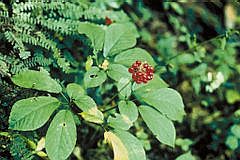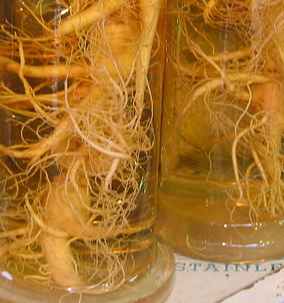|
GINSENG
|
|
HOME | BIOLOGY | FILMS | GEOGRAPHY | HISTORY | INDEX | INVESTORS | MUSIC | SOLAR BOATS | SPORT |
|
Panax is a genus of about five or six species of slow-growing perennial plants with fleshy roots, in the family Araliaceae. They grow in the Northern Hemisphere in eastern Asia (mostly Korea, northern China, and eastern Siberia) and North America, typically in cooler climates; Panax vietnamensis, discovered in Vietnam, is the southernmost ginseng found. Ginseng is characterized by the presence of ginsenoside.
Siberian Ginseng (Eleutherococcus senticosus) is not considered a true ginseng; instead of a fleshy root, it has a woody root; instead of ginsenosides, eleutherosides are present.
Some other species previously classified in the separate genera Polyscias and Pseudopanax.
Ginseng plant
History
The English word ginseng derives from the Chinese term rénshēn, literally "man root" (referring to the root's characteristic forked shape, resembling the legs of a man). It was originally the common name for several plants valued for their medicinal properties; although ginseng is now most often associated with the genus Panax, some researchers believe that the original ginseng used in ancient China may have been a different plant. Although ginseng is often seen as an East Asian medicine, American ginseng has been used by Native Americans for centuries. A wide variety of ginseng is generally available in many Chinese or Korean herbal medicine shops and ethnic Chinese/Korean supermarkets.
Modern science and ginseng
It has been difficult to verify the medicinal benefits of ginseng using modern science. Frequently, there are contradictory results from different studies. Supporters claim that this is due to the wide variety of ginseng quality used in studies. The quality and neutrality of studies from East Asia have also been questioned. Another issue is the profit potential of corporate research since ginseng cannot be patented. As a result, quality studies into the effects of ginseng are rare. Ironically, one of the better studies involving ginseng actually uses a proprietary formula of ginseng.
Ginseng is highly prized as an adaptogen (a product that does no harm, but increases the body's resistance to stress). Unfortunately, this property is extremely difficult to prove scientifically as well.
A comparative, randomized and double-blind government study does indicate it to be "a promising dietary supplement" when assessed for an increase in quality of life.
Panax ginseng appear to inhibit some characteristics associated with cancer in animal models; nevertheless, this effect is unclear in humans.
Ginseng's most common side effects are nervousness and excitability, which usually decrease after the first few days. The ability to concentrate may be decreased, and blood sugar may decrease to abnormally low levels (causing hypoglycemia). Because ginseng has an estrogen-like effect, women who are pregnant or breastfeeding should not take it, nor should children. Occasionally, there have been reports of more serious side effects, such as asthma attacks, increased blood pressure, palpitations, and, in postmenopausal women, uterine bleeding. To many people, ginseng tastes unpleasant.
Ginseng can interact with anticoagulants, aspirin (ECOTRIN, ASPERGUM), other nonsteroidal anti-inflammatory drugs (NSAIDs), corticosteroids, digoxin (LANOXIN), estrogen replacement therapy, monoamine oxidase inhibitors (MAOIs—used to treat depression), and drugs that decrease blood sugar levels (hypoglycemic drugs, used to treat diabetes).
Ginseng roots in a market in Seoul, 2003
Common classification
Wild ginseng
Wild ginseng is ginseng that has not been planted and cultivated domestically, rather it is that which grows naturally and is harvested from wherever it is found to be growing. It is considered to be superior to domestic ginseng by various authorities, and it has been shown to contain higher levels of ginsenoside. Wild ginseng is relatively rare and even increasingly endangered, due in large part to high demand for the product in recent years, which has lead to the wild plants being sought out and harvested faster than new ones can grow (it requires years for a ginseng root to reach maturity).
Red ginseng
Red ginseng is Panax ginseng that has been heated, either through steaming or sun-drying. It is frequently marinated in an herbal brew which results in the root becoming extremely brittle. This version of ginseng is associated with stimulating sexual function and increasing energy. Red ginseng is always produced from cultivated roots, usually from either China or South Korea. Some imported cultivated ginseng has tested positive for pesticides.
A double-blind, crossover study of Red ginseng's effects on impotence show a marked positive effect.
A study shows that Red ginseng reduces the relapse of gastric cancer versus control.
A study of ginseng's effects on rats show that while both White ginseng and Red ginseng reduce the incidence of cancer, the effects appear to be greater with Red ginseng.
Ginseng alternatives
These plants are sometimes referred to as ginseng, but they are either from a different family or genus.
LINKS and REFERENCE
A taste for adventure capitalists
Solar Cola - a healthier alternative
|
|
This website is Copyright © 1999 & 2006 NJK. The bird logo & name Solar Navigator and Solar Cola are trademarks. All rights reserved. All other trademarks are hereby acknowledged. Max Energy Limited is an educational charity. |
|
AUTOMOTIVE | BLUEBIRD | ELECTRIC CARS | ELECTRIC CYCLES | SOLAR CARS |

